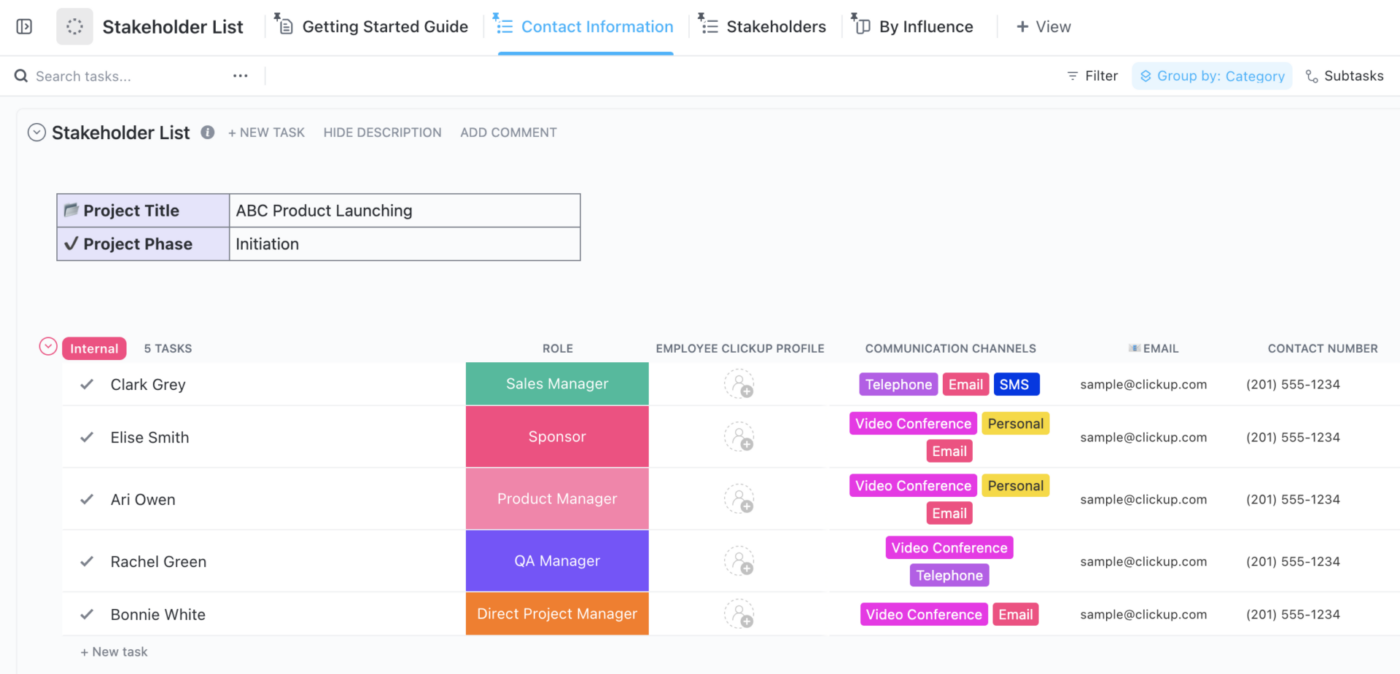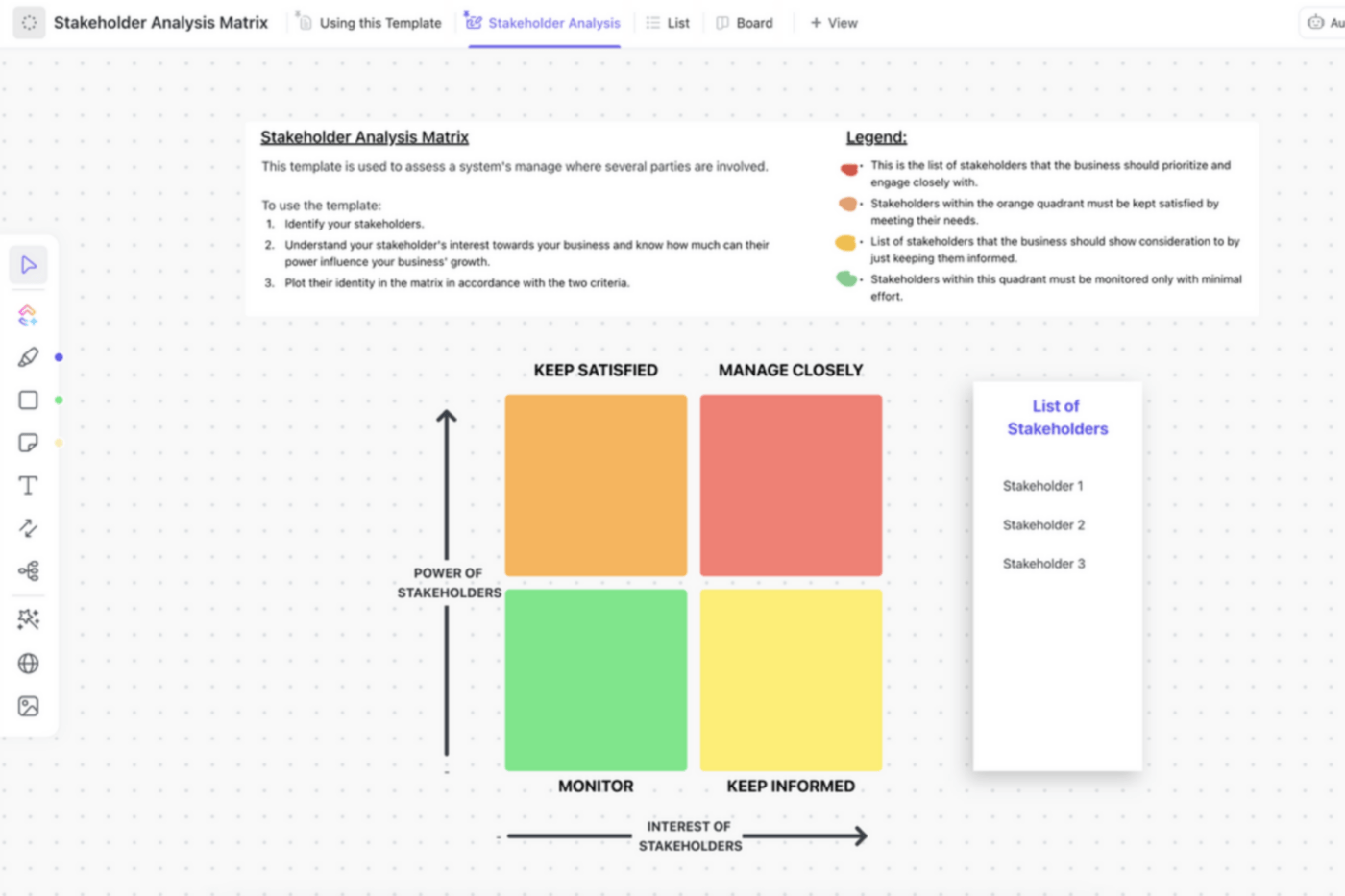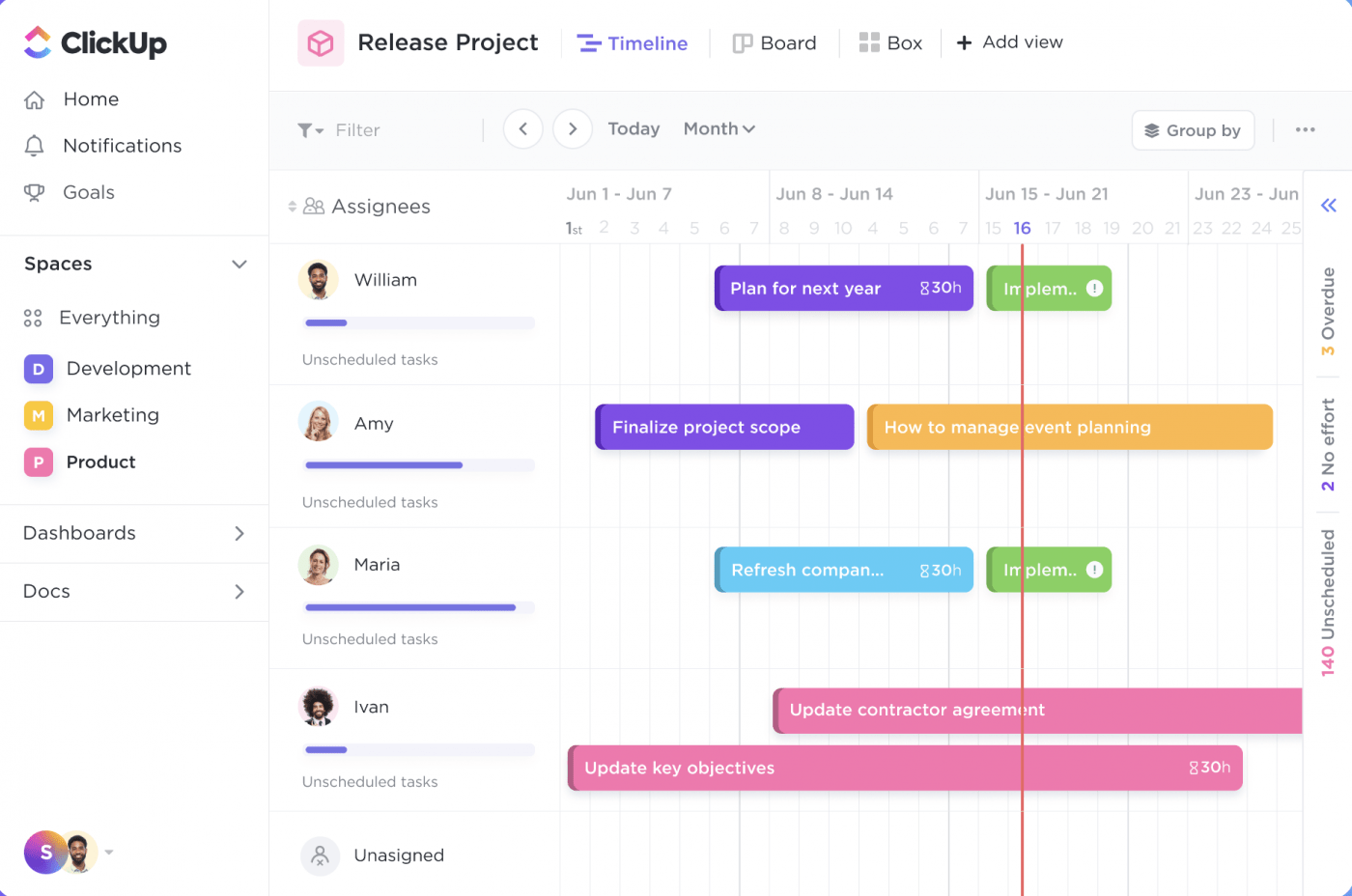

Every project has stakeholders, and it’s the way you build relationships with these people that can make or break your project. Strong relationships help build trust and empower your team to use their expertise to reach your project goals, while poor relationships can lead to conflict and unhappy clients.
Managing relationships with stakeholders requires time, effort, and intention. Make the whole experience run smoother with the help of a stakeholder management plan.
In this guide, we’ll cover the basics of stakeholder management, why it’s important, and how to create your own stakeholder management plan.
Let’s dive in.
What Is Stakeholder Management in Project Management?

Stakeholders are the people you work with (or for) during a project. They’re the people who are integral to the project’s success and those who should be kept updated on the project’s progress all the way through.
Stakeholder management is the art and process of building and sustaining a good relationship with these people throughout the project so you can achieve the best project outcome. 🏆
Project stakeholder management isn’t just about making a list of everyone who’s connected to your project, though. It’s a process that involves categorizing and prioritizing your stakeholders, as well as tailoring the way you communicate with each stakeholder.
The purpose is to create an experience that’s smooth, efficient, and effective for project stakeholders.
Types of Stakeholders
What is a stakeholder in project management? When we think of key stakeholders, we often think of the main client and any other beneficiaries—but in reality, your list of project stakeholders extends far beyond this.
A stakeholder is anyone who’s directly or indirectly impacted by your project and anyone who has a keen interest in it succeeding—such as an investor or government agency. This means you can have internal and external stakeholders in your project management plan.
Stakeholders are often influential, have a sense of decision-making power or a financial stake in the project, and fit a unique role within the project team—like the lead client or an essential partner. 🤝
The most common types of project stakeholders include:
- Clients
- Consultants
- Government agencies
- Project sponsors
- Investors
- Elected representatives
- Board members and executives
- Land or resource owners
- Vendors and suppliers (check out these vendor list templates)
- Contractors and subcontractors
- Project team members
- End users
- Members of the community
This list isn’t exhaustive. You might find that in your project there are internal stakeholders who occupy other roles or have unique responsibilities. At the start of a project, take time to identify stakeholders from every angle, being careful not to miss anyone.
Why Is Stakeholder Management Important?
Projects often have a lot of internal and external stakeholders, and keeping track of everyone and everything going on with the project itself quickly becomes a challenge without a good way to manage it all.
Stakeholder management is essential, allowing you to get organized, prioritize your stakeholders, and give your project the best chance of success. Effective stakeholder management helps you:
- Identify key stakeholders and make prioritizations
- Build strong and trusting relationships for effective stakeholder engagement
- Tailor your approach to match each stakeholder’s needs
- Handle roadblocks with the least potential impact
- Communicate effectively with every party throughout the project
- Keep stakeholders engaged over the project lifecycle
- Make project execution easier for all stakeholders involved
- Work better together to achieve your strategic objectives and project deliverables
For the reasons above and more, managing your stakeholders effectively is crucial to the successful outcome of a project. Without having a stakeholder management process in place, it’s almost impossible to keep the right people updated, at the right time, about the right details.
The best way to make this happen is with a strategic stakeholder management plan. 📄
How to Create a Stakeholder Management Plan
A good stakeholder management strategy plan gives you the framework you need to manage your stakeholders in the most effective way. Here’s a seven-step process for how to build your own strategy plan so you can work more closely with stakeholders and keep them engaged with what you’re working on.
1. Identify stakeholders
Before you can engage your stakeholders, you first need to know who they are. The first step in any successful plan is identifying your external or internal stakeholders. 🕵️
Think about your project scope and project objectives, and make a note of anyone who comes to mind as a potential stakeholder. Project managers should also include any entry on the list above, plus other members of the public, professional people or bodies, or partners that are involved in the overall project success metrics.
At the stakeholder identification stage, your list doesn’t have to be super detailed. As you move through the process you’ll categorize and prioritize your stakeholders. Right now the goal is simply to make an initial list.
2. Build a database of your stakeholders

Once you have a list of project stakeholders, you can start forming a more detailed picture of who they are and what their roles and responsibilities are. Now is the ideal time to start building a stakeholder list or stakeholder register, so you can use it to communicate with and engage them later on.
Gather details about your stakeholders, including what company or organization they work for, their title, their role within the project, how to contact them, and any essential notes—like an existing relationship or any known issues. 📝
Use the Stakeholder List Template by ClickUp to organize your stakeholder information in a simple, visual way. The template helps you easily differentiate between internal stakeholders and external stakeholders, or customize the labels to create your own categories. See a stakeholder’s name, role, communication channels, and contact details at a glance.
This template is incredibly helpful not only for organizing your data but for your team members when they need to quickly identify or get in touch with project managers or project leads.
3. Categorize and prioritize your stakeholders

While we should create the best experience possible for every stakeholder, not all stakeholders are created equal. Different stakeholder groups require slightly different management and communication styles, so identifying who is essential.
Use a stakeholder mapping process to identify your most important stakeholders. The Stakeholder Analysis Template by ClickUp helps you do this collaboratively with a user-friendly power/interest grid.
Place all your stakeholders on the matrix template grid according to where they fit in terms of their level of power (or level of influence) and level of interest. This stakeholder analysis strategy will allow you to understand which groups you need to pay close attention to and which can simply be kept informed of progress. 👀
For high-power and high-interest stakeholders (like project sponsors and clients), manage them closely and keep them satisfied and informed throughout. But stakeholder analysis can also help you find the low-interest and low-power stakeholders (like community groups or members of the public).
These folks may require a reduced level of engagement and can be kept informed occasionally and monitored lightly.
4. Develop a stakeholder communication plan
With your stakeholders prioritized, you next need a plan for how you’re going to communicate and engage with them throughout the process. It’s time to create a strategic stakeholder communication plan.
Consider every stakeholder within your project, and plan a personalized plan of outreach for each. Your stakeholder communication and engagement plan should cover:
- Your project communication or stakeholder engagement goals
- Communication methods or channels
- Communication frequency
- Style and tone
- Resources required to execute your communication plan
- Responsible team member(s) for each stage of your communication plan
- Potential messages or communication deliverables at various stages of your plan

In your communication action plan, you might specify that for your client you’ll provide weekly communications through Slack or email or through regular project meetings. For community members, you might send a monthly or quarterly project update via email. 📧
Building a tailored plan for every stakeholder group might sound overwhelming at first, but putting in the time and effort at the start makes it easier to stay accountable and consistent throughout the entire project lifecycle.
5. Assign resources to your plan

Having a plan is great, but you also need the right resources to allow you to actually deliver it. Consider what resources you need, then allocate them to your project plan and team members accordingly.
Some elements of your stakeholder communication plan will require more resources than others, but you’ll always need a team member’s time and energy to make it happen. Other potential resources include a budget for communication and design tools, printed materials, press events, promotional photography, and more. 📷
If you already use ClickUp or you’re considering making a move, there are plenty of templates to help you with resource management. Use the Resource Allocation Template by ClickUp to organize resource requests and get a clear overview of any agreed and assigned resources.
6. Share your plan with stakeholders
Once you’re happy with your engagement plan and you’re sure it’s realistic, it’s time to share it with your stakeholders. This might not sound like an obvious step, but it’s one that can help hugely with managing stakeholder expectations.
Share your communication plan for better stakeholder engagement to help them understand the process, your timeline of communications, and what they can expect to see. Think of your plan as a roadmap for how project managers stay in touch with each other during the project.

If both parties are aware of the plan, you can manage expectations while also feeling motivated to stay accountable and on track.
By sharing your plan and stakeholder mapping docs, you’re also making it easier to build a relationship with them. Engaging stakeholders can be tough—especially if they’re busy—so being open and transparent with them from the start can build trust and create a stronger bond that makes working together easier. 🤩
7. Monitor and adapt your plan
Even the best stakeholder plans can change, and yours should change sometimes if you’re doing stakeholder management right. As you move through the project lifecycle, new challenges and opportunities can appear—so it makes perfect sense to change your plan to match.
Work on managing stakeholders and your relationships with them throughout the project. Check in regularly to make sure your plan is effective. You might discover that your planned updates happen too frequently and it’s causing stakeholders to disengage.
You might find that the communication channels you chose just aren’t resonating with your stakeholder management plan. Monitor proactively, so you can make adjustments for the better. ⚒️
Stakeholder Management Plan Tips
Knowing you need a plan and understanding the best way to make it happen are two different things. Find ways to make a successful stakeholder management plan even more effective and successful with these five useful tips.
1. Make your plan more user-friendly
Your stakeholder management plan is not only an internal document to guide you, but one that you’ll share with the whole project team and maybe your stakeholders, too. This means it needs to be easy to understand, with clear and concise language.
Avoid getting too technical with the wording you use, and use diagrams, timelines, tables, and relevant imagery to break up text and provide helpful visuals, making the experience more user-friendly. ✨
2. Plan for the unexpected
We can’t plan for every eventuality, but we can anticipate some of the more likely problems. Make sure your plan features a risk management element that considers potential roadblocks and complications—along with ideas for how you’ll deal with them. ⚒️
You might plan to release updates on a specific schedule, but project delays and roadblocks mean these can get delayed. Consider moments where this might happen, and build in some padding in your schedule so you’re not always one step behind if you encounter a problem.
3. Be open and transparent
Transparency builds trust, and that’s something you want your stakeholders to have in you with abundance. Be open and transparent throughout the entire project so you have buy-in from your key project stakeholders and they trust you to do your best work.
Be honest about deadlines, timelines, and milestones so you can manage expectations. Admit when you’ve made a mistake, and apologize for any impact this may have had on others. Hold yourself and others accountable, and run your project with transparency and trust in mind for a truly successful stakeholder management plan. 🤝
4. Be available to your stakeholders
While you don’t need to be available to your stakeholders every minute of the day, they should feel like they have a good relationship with you and can get in touch if they have any questions. Set expectations early around who will be available to discuss the project and when so you can keep lines of communication open and appropriate. 📞
Assign a team member to be the go-to person for each of your key stakeholders—or someone for each group of stakeholders if you’re running a large-scale project. Provide stakeholders with contact details for the responsible team member, and let them know the best way to stay in touch between official updates.
Building communication reassures them, and it gives you another way to keep them engaged through an effective stakeholder management plan.
5. Use tools to make stakeholder management easier

Managing your stakeholders and the rest of your project process without the right tools can be a challenge. Luckily, we’ve built the best project management software out there—ClickUp.
ClickUp is the ideal hub for all your project management needs. Organize people, resources, budgets, and tasks. Create and monitor project management charts, timelines, to-do lists, and dependencies.
Get together for brainstorming or problem solving with Whiteboards, and collaborate on Docs to create project documentation for the entire team. Personalize your dashboard and see your project status in an instant, allowing you to work proactively and strategically. ✨
Create a Winning Approach to Stakeholder Management
Stakeholder management is crucial to your project planning process—especially if you’re working on a big or important project or one that spans a long time period, or if your project involves some high-priority clients. Use these tips to help you understand the process and build a stakeholder management plan that keeps everyone in the loop from start to finish.
If running successful projects is on your to-do list, consider using ClickUp as your go-to project management platform. ClickUp not only has specific templates to help you streamline the stakeholder management process, but it offers plenty of features and built-in templates to help with all areas of project management and productivity.
Hop aboard, and try ClickUp today for free to see what your new productivity hub could look like. 🤩



